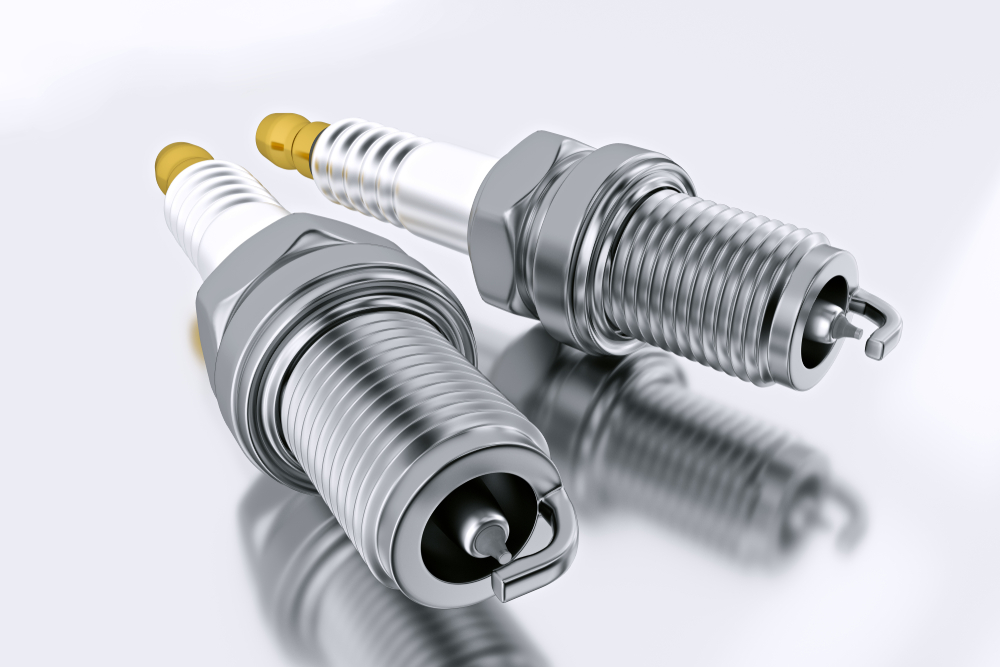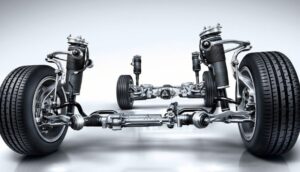Let me start this post by telling you a short story about my introduction to the world of spark plugs and cars in general.
In my early teenage years, we had a 1989 Mazda B2200 pickup truck with a 2.2L 4-cylinder carburettor engine and a 5-speed manual transmission that we used for farm running and providing rental services to people in need. This truck was nicknamed “Ferratti” or “Bugarri” by my friends because of how I used to manhandle it everywhere.

Interesting as this might sound, this truck showed me hell! It was a baptism-of-fire introduction to the world of cars. Every day came with a different ordeal; carburettor overflows were so regular that oral administration of fuel was the least of my concerns; clutch failures were so common that I learned to drive without one; brake failures? The brakes were never good and required 5 stomps to stop, I drove around with a keg of water, ever ready to add water to the radiator… I was an ever-present face at our mechanic’s workshop.
Most notable of all these car issues was the constant need to replace spark plugs due to misfiring.
You see, this vehicle smoked like a chimney, and its carburettor would regularly overflow, so as expected, it fouled spark plugs very quickly. So quickly that I had a stockpile of plugs and was ever ready to pop them out and replace them at a moment’s notice.
It was all good until a fateful day when I was trying to replace these plugs and I got a shock, both in the literal and figurative sense.
Let me paint the picture.
When a vehicle misfires, one way to brave it in the case of an intermittent misfire or a single-cylinder misfire is to increase the vehicle’s idle speed, this will reduce the impact of the misfire just enough to drive around it, and since the vehicle is a carburettor engine, that was quite easy.
On this day, I had just picked up the vehicle from the mechanic the day before, and I was driving alone in the bush, as was the case most of the time, (Dad worked very far away, mom was a teacher, my brother was in school, and I was a 15-year-old who loved money and wanted to be responsible) when the engine began to misfire again, I increased the idle speed and drove for a while, then the misfiring got worse, signalling multiple cylinder misfire. I parked with the engine still running, used a stone to stop the vehicle from rolling and got to work.
The challenge was to find the misfiring cylinder, so I began to remove the plug wires while listening to see which ones caused a change in engine tune and which ones didn’t (this is a crude way to check for a misfire, it can be dangerous as you would soon see).
As soon as I pulled the third spark plug wire, I noticed that I saw stars and found myself on the floor. You see, I’m not a stranger to electric shocks, and it was not the first time a car would do so to me, but because of the high idle engine speed, the coil was sending the high voltage to the spark plugs more quickly than I could react to.
I was left disoriented for a few minutes, and when I came to, the vehicle was still running, misfiring still with the coil wire just resting on the tip of the plug (lucky for me, because if it was dangling carelessly or in contact with the vehicle’s body, it could start a fire).
Still in pain, I picked up my phone and called the mechanic apprentice who fixed the car earlier and ranted so much that I said what I shouldn’t have, all of which I had to apologize for later.
I finally picked myself up, switched off the vehicle and solved the issue, even though I spent the rest of the day angry and weak.
It wasn’t until a few years later that I found out that I had experienced voltages as high as 10,000 volts for those few short seconds. If it had been longer than that…
That experience, among a few others, made me want to know cars and how they work. So here we are.
So why does this part need so much voltage to work?
Spark plugs… Why?
A car’s engine is a complex system of moving parts, electrical currents, and controlled explosions. At the center of this controlled chaos lies a small but powerful component—the spark plug. It might not look like much, but without it, your engine wouldn’t even start. The spark plug is responsible for igniting the air-fuel mixture inside the combustion chamber, creating the energy needed to power your vehicle.
Many drivers never think about their spark plugs until something goes wrong—poor fuel economy, rough idling, slow acceleration, or even failure to start. Understanding how spark plugs work, what causes them to fail, and how manufacturers design them for specific engine requirements can help every driver make better maintenance decisions and keep their car running smoothly.
How Spark Plugs Work: A Tiny Bolt of Lightning
At its core, a spark plug is a bridge for high-voltage electricity. The ignition coil sends an electric charge to the plug, which then generates a high-energy spark that jumps across a small gap at its tip. This spark ignites the compressed air-fuel mixture in the cylinder, creating a controlled explosion that forces the piston downward. This motion drives the crankshaft and, ultimately, powers the wheels.
This process happens thousands of times per minute while the engine is running. Each spark plug in a multiple-cylinder engine must fire in perfect sequence to keep the engine balanced and efficient. If a single spark plug misfires or fails, the entire engine can suffer from reduced performance, poor fuel efficiency, or even damage to other components.
Types of Spark Plugs and Their Differences
Not all spark plugs are created equal. While they all serve the same function, they differ in material composition, performance, and longevity. Understanding these differences can help you choose the best spark plug for your vehicle.
1. Copper Spark Plugs
These are the traditional spark plugs that have been in use for decades. They have a solid copper core and a nickel-alloy electrode. They need about 10,000V – 20,000V to spark.
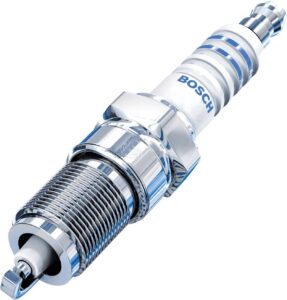
Advantages:
- Excellent electrical conductivity
- Lower cost compared to other types
- Works well in older engines and high-performance applications
Disadvantages:
- They have a short lifespan (20,000 – 30,000 km)
- They wear out faster due to the soft nickel electrode.
Best for: Older vehicles with distributor-based ignition systems and some high-performance engines.
2. Platinum Spark Plugs
These have a platinum disc welded to the center electrode, making them more durable than copper plugs. They usually need about 15,000V-35,000V to spark.
Platinum spark plugs, just like the iridium ones, have a needle-like tip on their centre electrodes unlike the copper spark plugs which are flat-bottomed
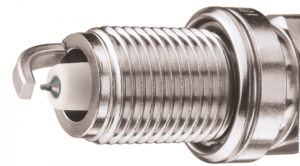
Advantages:
- They have a longer lifespan than copper spark plugs(80,000 – 100,000 km)
- They have better performance and efficiency compared to copper plugs.
- They are more resistant to carbon buildup
Disadvantages:
- They are more expensive than copper plugs.
- They have less heat dissipation compared to iridium plugs.
Best for: Modern fuel-injected engines that require longer-lasting spark plugs.
3. Double Platinum Spark Plugs
These have platinum on both the center and ground electrodes, making them even more durable than single platinum plugs. They require about 20,000V – 40,000V to create a spark.
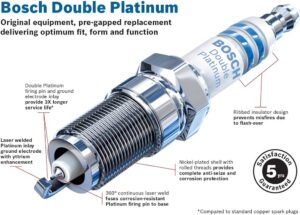
Advantages:
- Works well in vehicles with a “waste spark” ignition system
- Offers better longevity than single platinum plugs
- Resists wear better in harsh conditions
Disadvantages:
- More expensive than standard platinum plugs
- Not as efficient as iridium spark plugs
Best for: Vehicles with waste spark ignition systems, where plugs fire twice per cycle.
4. Iridium Spark Plugs
The most advanced spark plugs, featuring an iridium tip that is harder and more heat-resistant than platinum.
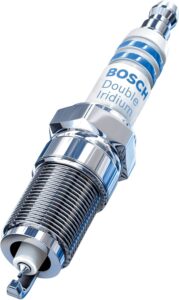
Advantages:
- Longest lifespan (100,000 – 150,000 km)
- Delivers the best fuel efficiency and engine performance
- Requires less voltage to produce a spark
- Handles high temperatures and pressures well
Disadvantages:
- More expensive than all other types
- Not always necessary for older engines
Best for: Modern cars with advanced ignition systems, turbocharged engines, and high-performance vehicles.
5. Silver Spark Plugs (Rarely Used)
These have silver electrodes, which provide the best electrical conductivity.

Advantages:
- Superior electrical conductivity
- Used in high-performance and specialty applications
Disadvantages:
- Short lifespan
- Hard to find in most markets
Best for: Some European performance cars and motorcycles.
Which Spark Plugs Are Interchangeable?
While it’s always best to use the manufacturer-recommended spark plug type, some options can be used interchangeably:
Copper → Platinum: You can replace copper spark plugs with platinum or double platinum plugs for better longevity. However, in older vehicles, 25 years and above, this might not be the case because platinum plugs require a higher voltage to create sparks and the old ignition systems might be incapable of producing such high voltages, further reducing the performance of the spark plugs.
Platinum → Iridium: If your car comes with platinum plugs, upgrading to iridium can improve performance and fuel efficiency.
Double Platinum → Iridium: While iridium plugs work in place of double platinum, the opposite isn’t recommended.
⚠ What NOT to do:
- Never downgrade from iridium to copper—your engine may not function properly.
- Avoid mixing different types of spark plugs in the same engine.
Why Spark Plugs Wear Out and Fail
Despite being built to withstand extreme temperatures and high pressure, spark plugs don’t last forever. The constant electrical arcing slowly wears down the electrodes, while exposure to combustion gases can lead to carbon buildup and corrosion.
- One of the most common reasons for spark plug failure is electrode wear. Over time, the spark plug’s center and ground electrodes erode, increasing the gap between them. This larger gap makes it harder for the spark to jump across, weakening ignition and leading to engine misfires.
- Another issue is carbon fouling, which occurs when unbuLastlyand oil deposits coat the spark plug, reducing its ability to generate a strong spark. This can happen due to incorrect air-fuel ratios, oil leaks into the combustion chamber, or excessive idling. In colder climates, moisture buildup can lead to fuel-fouled spark plugs, making it difficult for the engine to start.
- Some drivers experience overheating spark plugs, which can be caused by an engine running too hot, incorrect spark plug heat ranges, or using low-quality fuel. When spark plugs overheat, they can pre-ignite the air-fuel mixture too early, leading to engine knocking—a destructive condition that can damage pistons and valves.
Manufacturer Specifications: Choosing the Right Spark Plug
Spark plugs are not one-size-fits-all components. Each vehicle manufacturer designs their engines with specific spark plug requirements, considering factors such as:
Thread size and length – The spark plug must fit perfectly into the cylinder head. Using the wrong size can lead to poor combustion or even engine damage.
Electrode material – Different spark plugs use copper, platinum, or iridium electrodes, each affecting longevity and performance.
Heat range – Some engines require “hot” spark plugs that retain heat for better self-cleaning, while others need “cold” spark plugs to prevent overheating under high-performance conditions.
Gap spacing – The distance between the center and ground electrodes must match the engine’s design for optimal combustion efficiency.
Manufacturers spend years testing and refining spark plug specifications to match their engine’s power, fuel economy, and emissions standards. Using the wrong spark plug—even if it fits—can result in poor ignition, rough performance, and even engine damage over time. That’s why it’s crucial to follow the manufacturer’s recommendations when replacing spark plugs.
A Small Part with a Big Impact
The spark plug may be small, but it plays a critical role in engine performance, fuel efficiency, and reliability. Whether you’re driving a fuel-efficient sedan or a high-performance sports car, the right spark plugs ensure that every drop of fuel is burned efficiently, delivering maximum power with minimal emissions.
Regular maintenance and choosing the correct spark plug type will not only improve performance but also save money in the long run by preventing costly engine repairs.
Next time your car starts acting up, don’t overlook the spark plugs—they might just be the key to getting your engine back in top shape.
And lastly, when working on a vehicle’s electrical system; spark plugs, alternator, ignition coils and wires; adopt all safety measures possible so you will not have a terrible experience like I did.😁
I’d like to hear what you think and also take your questions in the comments section. Don’t forget to share with others.

